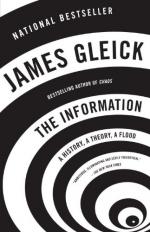
|
| Name: _________________________ | Period: ___________________ |
This test consists of 15 multiple choice questions and 5 short answer questions.
Multiple Choice Questions
1. It had long been noted that physical traits were inheritable and that they had something to do with what other human element?
(a) Amino acids.
(b) Chromosomes.
(c) DNA.
(d) Genes.
2. Why do scientists consider the belief in God a meme?
(a) Because all beliefs are contained in memes.
(b) Most scientists are atheists.
(c) Memes control reactions to external influences.
(d) It has been passed from person to person.
3. Charles Bennet went on to design what method for passing information?
(a) Passing information by electrical networking.
(b) Passing information by bytes.
(c) Passing information by circuit relays.
(d) Passing information by qubits.
4. What can the amount of information in a message be expressed in?
(a) By the algorithm that produces it.
(b) By its integral number.
(c) By the bits it contains.
(d) By the computation that produces it.
5. What did Chaitin determine about most numbers?
(a) That they are not computable.
(b) That they have complex alogarithms.
(c) That they can be compressed to manageable entities.
(d) That they are computable.
6. Why is the randomness of numbers difficult to define?
(a) Numbers have an unpredictability.
(b) Numbers are infinite.
(c) A number may be random to some but not to others.
(d) Numbers send different messages.
7. Why is the belief in God an enduring one?
(a) The memes retain beliefs.
(b) The belief is inherited.
(c) Beliefs are the only concepts that are passed on.
(d) Belief of God has been with mankind since the beginning.
8. What is the most probable state for an arrangement of molecules in a system?
(a) In an organized line.
(b) In an arc.
(c) In a jumble.
(d) Constantly and randomly movement.
9. Why do scientists view quantum particles in terms of probability?
(a) The exact properties of quantum particles are dynamic.
(b) The exact properties of quantum particles are not stable.
(c) The exact properties of quantum particles change.
(d) The exact properties of quantum particles are unknown.
10. Erwin Schrodinger used the concept of entropy to describe what group?
(a) Plant life.
(b) Microbes.
(c) Allergins.
(d) Living organisms.
11. How do scientists categorize catchphrases like "Survival of the fittest" and "Read my lips"?
(a) As memories.
(b) As bytes.
(c) As memes.
(d) As bits.
12. What did cosmologist George Gamow immediately recognize about DNA as a code and proposed that it could be deciphered mathematically?
(a) It was dynamic and ever-changing.
(b) It was a code and it could be deciphered mathematically.
(c) It was a code and it could be cloned.
(d) It was a code and it could be developed to duplicate.
13. What results when a closed system's temperature evens out?
(a) More work can be accomplished.
(b) There is no change.
(c) No work could be done.
(d) The system fails.
14. How does Gleick see the universe?
(a) As a cloud of quantum particles.
(b) As a giant computer.
(c) As a colossal Internet.
(d) As an infinite stream of knowledge.
15. What does Gleick compare the "Library of Babel" to?
(a) Quantum consciousness.
(b) Search engines.
(c) The M-Theory.
(d) The Internet.
Short Answer Questions
1. What is a fundamental problem in quantum mechanics?
2. What does the author compare the famous library to?
3. What did Seth Lloyd, a quantum engineer at MIT, base his estimates on the universe on?
4. What is the normal state of quantum particles?
5. What happened to the library that once held all known information?
|
This section contains 640 words (approx. 3 pages at 300 words per page) |

|




